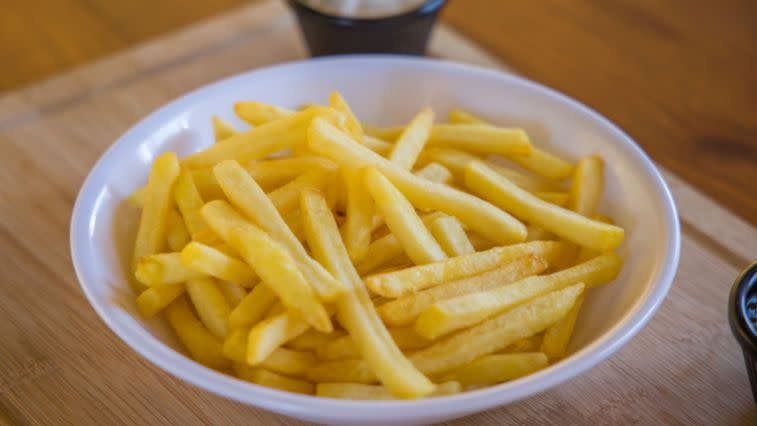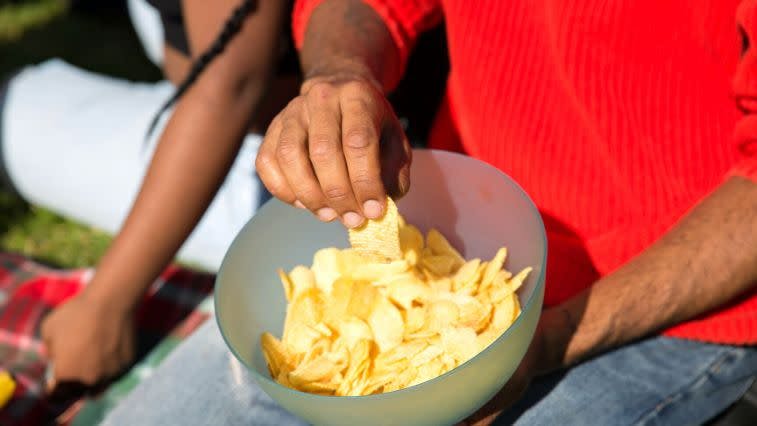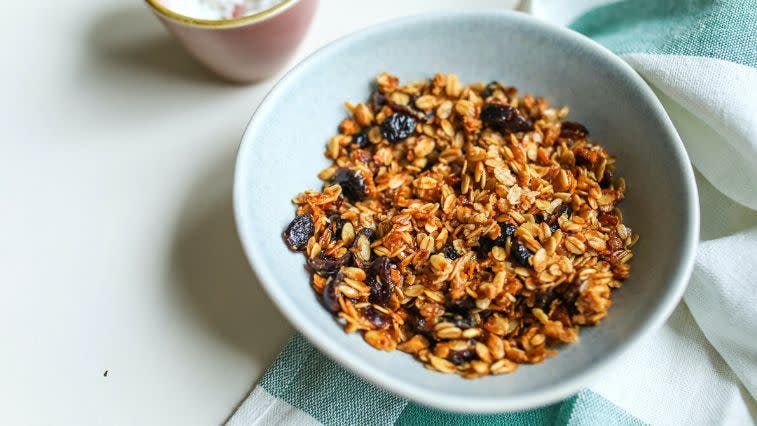An RD’s Advice on Foods to Avoid to Lose Weight
Our content strives to support, inform, and motivate you to meet your health goals. We want to be your trusted source of expert- and science-backed info dispensed in simple, actionable ways. Read our Editorial Guidelines.
Sustainable weight loss requires lifestyle and behavior changes — including balanced nutrition with healthy eating habits, regular exercise, high-quality sleep, and stress management — that you can commit to for the long haul.
Eating a healthy diet should be your overall goal when trying to lose weight. While no one food or food group causes weight gain on its own, high consumption of added sugars, refined carbs, highly processed foods, and sugary or alcoholic beverages can lead to weight gain and make weight loss very difficult.
For my clients who are trying to lose weight, I recommend including more fruits and vegetables, lean protein sources, whole grains, and healthy fats while reducing intake of the following list of foods.
What Should I Eat to Lose Weight?
To lose weight, focus first on making changes that improve your overall diet quality. If you really love a food or beverage that isn’t helpful for weight loss, try eating moderate amounts occasionally as a treat instead of including the food or drink in your regular daily routine.
We don’t recommend calorie counting as an optimal strategy for weight loss, but having some awareness of the foods you’re eating can be helpful. Remember that small steps in a more healthful direction can make a big difference in your overall wellness, even if you don’t notice significant weight loss right away.
A healthy diet consists of the following food groups:
Fruits
Vegetables
Proteins: lean meats, chicken, fish, eggs, tofu, tempeh
Healthy fats, which includes olive oil, avocado, nuts and seeds
Legumes: peas, beans, lentils, soy
Whole grains: whole-wheat products, bulgur, quinoa, brown rice
Low-fat dairy or dairy substitutes
According to the 2020 Dietary Guidelines, about 85% of the calories any person needs every day are required just to meet the food group recommendations. For most people, that leaves about 250–350 discretionary calories each day from other areas, like extra sugars, fats, an extra serving of a preferred food group, or alcohol.
For weight loss, reduce the types of foods that fall into the discretionary calories category:
Foods with added sugars
Foods high in unhealthy fats (for example, deep-fried foods and packaged pastries)
Empty calories from alcohol
While a healthy diet is always the goal and some foods provide more nutritional value than others, there are no secret fat-burning foods for sustained weight loss. Though a practice such as sipping hot lemon water may be enjoyable, it won’t burn fat or cause weight loss on its own without other habit changes.
10 Dietitian-recommended Foods to Avoid to Lose Weight

1. Deep-fried Foods
Deep-fried foods, such as french fries, fried chicken nuggets, fried fish, or even deep-fried vegetables, contain many more grams of fat than their baked or pan-cooked counterparts. Since fat has more calories per gram than the other macronutrients, this makes deep-fried foods much more energy-dense. Several studies link regular fried food intake with being overweight.
It’s OK to eat fried foods occasionally if you’re craving french fries, for example, but a better choice most of the time would be choosing the baked or grilled versions. Try baking proteins in a coating of whole wheat panko bread crumbs for a similar crunch to frying. Potatoes cut into slices and roasted with olive oil on high heat in the oven are almost as satisfying as the fried version of french fries, too.
2. Sugary Drinks
Many studies have found a link between habitually consuming sugar-sweetened drinks and gaining weight. If you’re trying to lose weight, regularly consuming added sugars in drinks like flavored coffee drinks, sodas, energy drinks, fruit drinks, or sweet teas will likely make weight loss difficult.
One regular 12-ounce Coca-Cola has about 150 calories from sugar, while a medium sweet tea from McDonald’s contains 29 grams of added sugar and 130 calories. You could try swapping unsweetened tea, herbal teas, coffee with minimal added sugar, or sparkling flavored water to meet the same craving for a flavored drink or energy boost.
Encouragingly, a four-year study found that swapping sugar-sweetened beverages and juices with unsweetened drinks such as water, tea, diet beverages, milk, or coffee were all inversely associated with weight gain.
3. Fruits With Added Sugars
Any kind of fruit might seem like a healthy snack, but some types of fruit include a hidden source of added sugars and calories. Canned fruits, fruit cups, fruit cocktails, and dried fruits are often sources of added sugar.
Instead of a handful of dried fruit, which has a very small suggested portion size, try a serving of fresh fruit and a protein food as a snack, such as a mozzarella cheese stick and two clementine oranges. Another satisfying fruit snack is apple slices or a banana dipped in nut butter. Fresh fruit plus a quick protein should provide more filling staying power without any added sugars.
4. Potato Chips

Potato chips are an easy food to overeat, given the small portion size and satisfying taste combination of fat and salt. In a study of more than 120,000 people, participants gained an average 4 pounds over four years. That weight gain was strongly associated with eating several food types, including potato chips.
Instead of grabbing a bag of chips, choose a snack with some fiber and healthy fats to make the snack more satisfying overall. Dip a serving of whole-grain crackers or baby carrots in hummus. If you crave crunch, you could also try baked chips or popcorn made without added butter.
5. Processed Meats
Processed meats like sausage, hot dogs, bacon, and salami contain high amounts of saturated fat. These meats aren’t good choices for overall health, and eating them regularly puts you at risk for colorectal cancer. A review article found that eating higher quantities of red and processed meats was directly associated with risk of obesity, higher BMI, and larger waist size.
Try to eat processed meats in smaller servings and less often. Instead of processed meats, try including protein sources with minimal processing, such as lean cuts of meats, chicken, fish, and beans.
6. Granola and Sugary Cereals

Sugary cereals and granola can pack a lot of extra sugar into a small serving size. Though cereals and granola are often thought of as healthy, the portion size is small and easy to overeat.
Try swapping in whole-grain cereals with limited added sugars (compare labels at the grocery to double check), or consider making a batch of homemade granola so you can control the amount of sugar or honey you add. Swapping refined grains for whole grains has also been linked to lower amounts of belly fat.
7. Alcohol

Alcohol has extra calories but provides no nutrition value since it has no vitamins and minerals. A typical beer contains between 100–200 calories, depending on how it’s brewed (craft beers tend to have more calories). Hard alcohol like vodka has about 100 calories per ounce, but calories add up quickly if you use a mixer like soda or juice.
Poor food choices are also associated with alcohol usage, which can lead to weight gain. A study found that calorie intake significantly increased with increased alcohol consumption. At the same time that calorie intake increased due to alcohol, healthy eating scores significantly decreased.
Instead of choosing alcohol, try relaxing with another drink that might feel special, such as a hot mug of herbal tea, club soda with lime, or a glass of kombucha.
8. High-calorie Condiments
While condiments are delicious compliments to many meals, they’re also a hidden source of extra calories. Ranch is a common dipping condiment, and 2 tablespoons of full-fat ranch contains about 130 calories per serving. Condiments like cream cheese or mayonnaise are also a concentrated source of calories and fat, and easy to overuse.
To lower energy intake, try pouring out a smaller dollop of dressings and other condiments on the side of your plate, or try to eat more meals without a condiment. If you season food appropriately with herbs and spices during the cooking process, you might find that you don’t need to rely on condiments for flavor.
9. Pastries, Cookies, and Cakes
According to the 2013–2016 NHANES data quoted in the 2020–2025 Dietary Guidelines for Americans, 19% of added sugars in the American diet come from desserts and sweet snacks. Pastries, cookies, and cakes are high in overall calories from added sugars and fat, and low in other important nutrients like vitamins and minerals. Portion sizes of pastries and cakes can be quite large, too, which makes moderation difficult.
To lower your intake of sweet snacks and desserts, try satisfying your sweet tooth in a more healthful way. Substitute a square or two of dark chocolate or some fresh berries with a dollop of whipped cream if you feel hungry for dessert.
10. Takeout Foods
Americans typically eat about one-third of their calories away from home. While takeout can be nutritious and fit into your goals, weight loss might be difficult if you don’t prepare food at home most of the time. Restaurant portion sizes are often larger than you might eat if you cooked for yourself at home, plus they contain added fats and sugars that you might not realize are present.
Instead of defaulting to takeout after a busy day, try keeping your refrigerator and freezer stocked with some easy ingredients to make a meal quickly. If you cooked a batch of whole grains on the weekend, you could quickly make a grain bowl after sauteing some chicken or tofu with frozen vegetables with a splash of soy sauce for flavor. Or, toast some whole-grain bread, smash some avocado on top, and add a fried egg or two for a very quick and delicious meal to prepare at home in a pinch.
The Bottom Line
Though there are no forbidden foods, a diet high in sugar or other foods with little nutritional value doesn’t help improve the quality of your diet or overall health. For the best chances at weight loss, focus on eating nutritious foods from all the food groups and avoid or reduce foods associated with weight gain. Remember that small changes are still progress and you don’t have to radically change your diet in a short period of time.